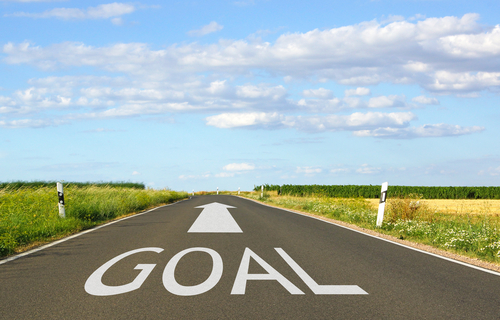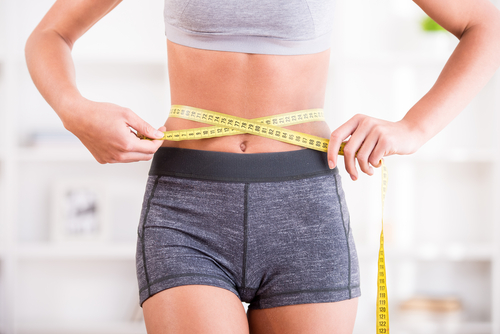Remove temptations
You’ll also need to remove any edible temptations. Start by using up or throwing away any of the foods you’ll need to avoid from your fridge or larder. This is a great time to have people round for dinner! Restock your kitchen with the recommended foods and drinks. Do the same at work.
Some of the foods on this diet may be new to you, but all of them are readily available in your local health food shop, supermarket or good greengrocer’s. There’s a shopping list for you in my books.
Setting your targets
Most people start diets hoping to lose in a month what they gained in a year. They vow never to eat chocolate again and to exercise every day. This approach usually ends in failure. So here’s my advice on easing into this new way of eating and exercising.
1. Be realistic
Be realistic, and take it one step at a time. Set yourself targets for changing your diet and taking exercise that you know you will reach. The weight will look after itself. It is far better to take one step towards permanently changing your lifestyle than to take four steps forward and four steps back because you were overambitious to start with.
After all, we often eat because we are under pressure or stressed. Boredom, frustration, anger or a lack of direction all lead to feelings that can be temporarily suppressed with food. Even making small dietary changes is, to begin with, stressful. It takes time to adjust. So don’t add to your stress by expecting too much from yourself and then failing to meet your targets.

2. Be patient
It took years to put on weight. Does it really matter if you take months, rather than weeks, to lose it? Our impatience drives us towards the countless ‘get-slim-quick’ diets that have been shown, time and time again, not to produce long-term results.
It is hard for the body to lose more than 2lb(1kg) of actual fatThere are many different types of fats; polyunsaturated, monounsaturated, hydrogenated, saturated and trans fat. The body requires good fats (polyunsaturated and monounsaturated) in order to… in a week, although you can also lose a lot of excess fluid when you stop eating something you’re allergic to. Anything more rapid is likely to be mainly the short-term loss of fluid caused when you eat too little carbohydrateCarbohydrates are the primary source of energy for the body as they can be broken down into glucose (sugar) more readily than either protein or… for energy production, leaving the body to break down stores of glycogen. Glycogen is stored with water – hence the apparent loss of fat that’s really loss of water.
Obviously, this won’t be happening with my diet: good-quality, low-GL carbs are an important part of it, as is sure and steady weight loss.
What results can I expect?
According to studies on the Holford Diet, the average weight loss achieved is 1–2lb a week over a 12-week period. That’s 1–2 stone (14–28lb) in less than three months. It is better not to lose weight faster than this. Weight loss of over 2lb a week will not be all fat loss.
Generally speaking, a good target during the first 30 days is to lose 7lb. This is easily achievable. You can accelerate this by adding 3 grams of Carboslow, glucomannan fibreFibre is an important part of a balanced diet. There are two type of fibre; soluble and insoluble. Insoluble fibre helps your bowel to pass…, either taken as a teaspoon with a large glass of water, or 3 capsules before each main meal. This not only makes you feel fuller but has been shown to help weight loss. In a recent study those on glucomannan lost 5lbs more over 60 days, compared to placebo, almost 4lbs of which was fat loss.
Don’t forget that your body fat percentage is far more important than your weight, so don’t rely on your scales as the only means for checking your progress. Some sports centres have body fat scales. As you begin to make more lean muscle you won’t lose so much weight, because lean muscle is heavier than the fat your burn off. But you will lose inches, since muscle is more compact than fat.
Making muscle is good news not only because you’ll look leaner. Muscle cells are more metabolically active and therefore have the capacity to burn off fat, while fat cells don’t. So, as you make more lean muscle, your ability to burn fat increases.

Week-by-week planning
When setting your target, it is good to have long-term and short-term objectives. Let’s call your long-term objective your goal. What weight would you like to be, ideally? The following questions help to give you a realistic yardstick to go by.
- What do you weigh now?
- What, in your opinion, is your ideal weight?
- When were you last that weight?
- What is the most you’ve ever lost on a diet?
When you’ve answered these questions, you’ll have a good idea of your ultimate goal. Once you’ve set it, you can work out your target, week by week. For example, if you want to lose 15lb, your target after one week would be to weigh 1½lb less and so on for 10 weeks, until you achieve your goal.
For more support on following a low GL diet read The Low GL Diet Made Easy or Low Gl Diet Bible. which contains the Low Gl Diet Counter. The Low Gl Diet Cookbook gives you further recipes. Also, if you’re entertaining, try one of the recipes in Delicious, Healthy, Sugar-Free which are all low GL. Talking of sugar, make sure you have some xylitolXylitol is a completely natural sweetener that looks and tastes like sugar. It is naturally occurring in many fruits and vegetables…., which has a ninth of the GL of regular sugar. If you’re tempted, one sachet is only 1 GLs. Many people find it helps to join a weight loss group for support – Zest4Life provide this kind of support around the country for low GL dieters – visit their website to find a group near you.


Comments
Join the Conversation on our Facebook Page